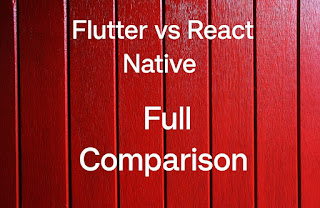1. Introduction
In the dynamic realm of cross-platform mobile and web development, making the right technology choice can deeply impact the success of your projects. This comprehensive comparison dig deep into the world of two prominent contenders: Flutter and React Native. As businesses and developers increasingly seek efficient ways to create applications that function seamlessly across multiple platforms, understanding the distinction of these frameworks becomes crucial.
In this exploration, we will dissect the key features, performance metrics, development experiences, and ecosystem of both Flutter and React Native. By the end of this analysis, you will be well-equipped to make an informed decision, tailored to your specific project requirements. Whether you're a seasoned developer or just venturing into the realm of cross-platform development, this guide will serve as your compass in the Flutter vs React Native journey, ensuring that your choice aligns perfectly with your goals for mobile and web development success.
Table of Contents:
1. Introduction
2. What is Flutter?
2.1. Key Features
2.2. Pros of Flutter
2.3. Cons of Flutter
3. What is React Native?
3.1. Key Features
3.2. Pros of React Native
3.3. Cons of React Native
4. Performance Comparison
5. Development Experience
6. UI/UX Design
7. Community and Ecosystem
8. Popularity and Adoption
9. Documentation and Learning Curve
10. Conclusion
2. What is Flutter?
Flutter, a product of Google, has emerged as a game-changing technology in the realm of cross-platform mobile and web development. At its core, Flutter is an open-source UI software development toolkit designed to create natively compiled applications for mobile, web, and desktop from a single codebase.
What sets Flutter apart is its unique approach to UI development. It utilizes a widget-based architecture, enabling developers to construct highly customizable user interfaces using pre-designed widgets. The Dart programming language, chosen for its robustness and performance, serves as the backbone of Flutter applications.
One of Flutter's standout features is "hot reload," allowing developers to witness real-time changes in their code, significantly accelerate the development process. This rapid development cycle is particularly valuable for iterative testing and refinement.
Furthermore, Flutter's single codebase can be employed across various platforms, sparing developers from the burdensome task of writing platform-specific code. This versatility has led to the widespread adoption of Flutter in diverse industries, from startups to tech giants.
In summary, Flutter is an innovative cross-platform development toolkit renowned for its performance, flexibility, and efficient development workflow. Its ability to create seamless user experiences across multiple platforms makes it a formidable contender in the Flutter vs React Native showdown for cross-platform mobile and web development supremacy.
2.1. Key Features
Hot Reload:
Developers can see the changes in real-time, making the development process highly efficient.
Widget-based:
Flutter's UI is built using widgets, making it highly customizable.
Single Codebase:
One codebase can be used for multiple platforms.
Dart Programming Language:
Flutter uses Dart, a modern language known for its robustness.
2.2. Pros of Flutter
a. Excellent performance due to the use of native compilation.
b. Rich widget library for customizable UI.
c. Fast development cycle with hot reload.
d. Strong community and growing ecosystem.
2.3. Cons of Flutter
a. Smaller community compared to React Native.
b. Limited third-party libraries compared to some other frameworks.
3. What is React Native?
React Native, a brainchild of Facebook, stands as a important player in the landscape of cross-platform mobile and web development. It represents an open-source framework that empowers developers to craft mobile applications that function harmoniously across both iOS and Android platforms.
At its essence, React Native relies on the familiar terrain of JavaScript and React, leveraging the strengths of these languages for app development. This translates into a highly efficient development process, as it allows developers to write code once and deploy it on multiple platforms.
One of React Native's remarkable strengths lies in its component-based structure. Developers build reusable components, which not only simplifies the development process but also ensures a native look and feel for the end product. This native compatibility is a driving force behind React Native's popularity and its ability to deliver outstanding user experiences.
Moreover, React Native boasts a vast community and a plenty of third-party libraries, facilitating problem-solving and enhancing development efficiency.
In summary, React Native is a powerful and well-established framework for cross-platform mobile and web development, rooted in JavaScript and React. Its component-based approach, along with a robust ecosystem, makes it a compelling contender in the ongoing comparison with Flutter, as both challenge for supremacy in the cross-platform development arena.
3.1. Key Features
JavaScript:
Developers can use JavaScript, a widely known language.
Reusable Components:
React Native uses components for building UI elements.
Native Look and Feel:
Applications developed using React Native offer a genuine native appearance and user experience.
3.2. Pros of React Native
a. Wide community support and third-party libraries.
b. Existing knowledge of JavaScript can be leveraged.
c. Strong performance through native code integration.
3.3. Cons of React Native
a. Occasionally slower than Flutter due to JavaScript bridge.
b. Compatibility issues may arise with third-party native modules.
4. Performance Comparison
Flutter, with its native compilation, tends to offer slightly better performance compared to React Native, which relies on a JavaScript bridge. However, React Native's performance is still quite good and suitable for most applications.
5. Development Experience
Flutter's hot reload feature provides a superior development experience. React Native also offers fast development, but some developers prefer the instant feedback provided by Flutter.
6. UI/UX Design
Flutter's widget-based approach makes it highly flexible and customizable for creating stunning UIs. React Native, with its component-based structure, also enables good UI/UX design but may require more effort for complex designs.
7. Community and Ecosystem
React Native has a larger community and more third-party libraries, making it easier to find solutions and resources. Flutter's community is rapidly growing, but it's not as extensive as React Native's.
8. Popularity and Adoption
React Native has been around longer and has a higher adoption rate. However, Flutter is gaining popularity quickly, thanks to its performance and development experience.
9. Documentation and Learning Curve
React Native's extensive documentation and existing knowledge of JavaScript can reduce the learning curve for many developers. Flutter's documentation is also robust, but the Dart language may require some adjustment for those unfamiliar with it.
10. Conclusion
In the realm of cross-platform mobile and web development, the choice between Flutter and React Native can shape the course of your projects. This comprehensive comparison has precisely explored the strengths and weaknesses of these two prominent frameworks, enabling you to make an informed decision.
In conclusion, Flutter offers exceptional performance and a highly customizable UI, making it an ideal choice for projects where a native look and feel are outstanding. React Native, with its vast community and existing JavaScript knowledge base, remains a strong contender, particularly for those who value extensive third-party library support.
Ultimately, the decision boils down to your project's unique needs and your team's familiarity with the respective technologies. Both Flutter and React Native have proven their worth in the world of cross-platform development. With this comprehensive guide as your reference, you're well-equipped to navigate the complex terrain of mobile and web development, ensuring your choice aligns perfectly with your goals for success in the ever-evolving digital landscape.













